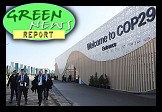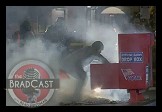READER COMMENTS ON
"[Live Blog] PM ADDRESSES NATION: RADIATION LEVELS RISING, EVAC ZONE EXPANDED, FIRE AT UNIT 4, ASKS FOR CALM | THIRD EXPLOSION AS BLAST HEARD AT FUKUSHIMA UNIT 2"
(42 Responses so far...)
COMMENT #1 [Permalink]
...
plunger
said on 3/14/2011 @ 5:26 pm PT...
Totally out of control. How many spent fuel rods were launched into the atmosphere with these three blasts? Thousands.
COMMENT #2 [Permalink]
...
Ernest A. Canning
said on 3/14/2011 @ 5:28 pm PT...
COMMENT #3 [Permalink]
...
MG in CA
said on 3/14/2011 @ 5:52 pm PT...
The first two syllables of Fuk-u-shima really sums this up, sadly.
COMMENT #4 [Permalink]
...
kbman
said on 3/14/2011 @ 6:01 pm PT...
"How many spent fuel rods were launched into the atmosphere with these three blasts? Thousands. "
Where on earth did you get this information? From your imagination is most likely. Hydrogen is not that powerful an explosion and the path of least resistance was out the cladding of the top of the building. If ANY fuel rods had been "launched into the atmosphere" they would be seen in the videos, their presence would be known everywhere they landed, and the plumes from the explosions would be screaming hot radiologically. None of this happened. Please stop making stuff up and pretending it is real.
COMMENT #5 [Permalink]
...
zapkitty
said on 3/14/2011 @ 6:08 pm PT...
... plunger said on 3/14/2011 @ 5:26 pm PT...
"Totally out of control. How many spent fuel rods were launched into the atmosphere with these three blasts? Thousands."
Screech.
To point out the silliness of your assertion... where would these thousands of tons of rods have been launched too?... from a structure designed to give way under a blast?
It's bad... damn bad.
It's going to get much worse before it gets better.
Screeching doesn't help.
COMMENT #6 [Permalink]
...
plunger
said on 3/14/2011 @ 6:08 pm PT...
KBMAN:
You've got some reading to do. The spent fuel rods were stored above each of these reactors - thousands of them:
http://www.dcbureau.org/...losion-at-fukushima.html
scroll down the page and see the diagram of these facilities. See the orange tray at the top of the building? THAT is where spent fuel rods were stored. See if you can spot one in any of the remaining destroyed structures. Tell me where you think the spent fuel rods went.
COMMENT #7 [Permalink]
...
plunger
said on 3/14/2011 @ 6:12 pm PT...
COMMENT #8 [Permalink]
...
zapkitty
said on 3/14/2011 @ 6:16 pm PT...
Responding to Lora from the previous thread.
https://bradblog.com/index.php?p=8393
... Lora said...
"Indeed I don't run screaming. I was once a scientist (once a scientist always a scientist?) and used the "nuclear power" of radioactive isotopes in many experiments (and experienced a spill which caused me to have to collect my urine for 24 hours to see if it glowed in the dark!
(Well...really to see if it registered on the scintillation counter at all. It didn't, over background, anyway.)"
Mine did, but they'd just imaged my heart so they let it pass... that time.
"But, I stand by Greenpeace's quote. Nuclear power, such as we have at this time in this country or in this world, is simply NOT safe in any way."
Well, that depends on your defined level of "safe." New uranium fission designs are far safer than the old ones at Fukushima. Thorium fission designs are far safer than the new uranium fission designs and produce waste that is much less dangerous. Hydrogen fusion would be far safer than the thorium fission designs and would produce less waste. The new aneutronic boron fusion designs would be safer than hydrogen fusion and would have no waste... so where would you draw the line?
"Whether it ever can be MADE safe is debatable, and somehow I think I'd take government assurances of nuclear energy safety about as much as I would take assurances of safety of deep ocean oil well rigs, or natural gas fracking, or any of that sort of stuff."
True, especially so for a government owned by the oligarchs. But the same would go for any new technology, correct? So what kind of consensus would you want that a new power technology lives up to its safety claims?
The MIC branch of the oligarchs did tremendous damage with their early insistence on uranium plants uber alles in order to produce the mass quantities of nuclear warheads needed for the inevitable endless (and profitable) series of atomic wars that were anticipated. (Just in case you ever wondered just how stupidly psychopathic our owners actually are... now you know.)
But we can't live under their shadow forever.
"And the trouble is, once radiation is leaked into the world, it ain't going away for a very, very, very long time.
Background radiation is higher than it used to be. Think about that. I, for one, do not want to let any more of that type of genie out of the bottle. This is one that really can't be put back in once it's out."
So one of your limits on a new power technology would be no nuclear waste whatsoever?
COMMENT #9 [Permalink]
...
Paul
said on 3/14/2011 @ 6:27 pm PT...
Brad, thank you for real news and information. I could not stand listening to our mainstream INS (Idiotic News Services) on cable and watching the same videos replayed a million times. Our prayers and a Red Cross donation are with the Japanese people.
COMMENT #10 [Permalink]
...
zapkitty
said on 3/14/2011 @ 6:37 pm PT...
Well, Brad, at least one mystery has been solved... now we know why they kept referring to the containment as "the container." The container holding the reactor is the containment.
A full-fledged containment structure would be really nice about right now.
COMMENT #11 [Permalink]
...
zapkitty
said on 3/14/2011 @ 9:29 pm PT...
... plunger said...
"http://www.dcbureau.org/...losion-at-fukushima.html
scroll down the page and see the diagram of these facilities. See the orange tray at the top of the building? THAT is where spent fuel rods were stored."
errrrrrrrrr.... that's a crane.
A specialized part of the fuel handling system.
"See if you can spot one in any of the remaining destroyed structures."
I could believe that the cranes are nowhere to be found in the pictures... as they were not in use at the time of the quake.
"Tell me where you think the spent fuel rods went."
They went nowhere. The center of the reactor section pokes upward like a tower from the lower level and the pools are set flush around that tower at about the level of the top of the tower.
Note the straight lines in the post explosion pictures where the skeleton of the weather housing abruptly shows through.
There's a reason for that. You've been staring at the pools, or rather their covers, all along.
COMMENT #12 [Permalink]
...
David Lasagna
said on 3/14/2011 @ 10:08 pm PT...
Dear Zapkitty,
Here's where I take issue with you.
1. As we are seeing, when something goes wrong with a nuclear reactor the possibilites for something going VERY wrong are horrifying. It's smarter to pursue technologies that are designed to fail without nightmarish consequences. Failure that is easily and safely remedied is what intelligent engineering should incorporate into design.
2. You talk about these other more efficient, sensible, safe ways of doing nuclear power. But so far none of them have panned out.
3. For me Amory Lovins makes a convincing case that economically the pursuit of nuclear energy makes no sense.
4. For me Helen Caldicott makes a convincing case that for health reasons pursuit of nuclear energy makes no sense.
5. For me Jerry Mander is right when he argues against the bromide--it's not the technology, it's how it's used. He's correct when he points out that certain technologies have specific requirements due to their nature, usually unmentioned and so undiscussed, that have consequences, effect the way we live, and influence what is possible and what is not. For instance, nuclear power requires a strong centralized government power(strong militaries) to guard highly poisonous fuel for thousands and thousands of years.
6. Continuing to dream of some version of "safe" nuclear power only helps perpetuate the untenable cultural narrative we're currently killing ourselves and the rest of the planet with.
7. We need a new narrative. More earth and humanity and all living things friendly. Where we take the gifts of the sun and reorient ourselves in a much more humble and loving way towards all creation to create a sustainable alternative narrative. And come to see THAT as truly beautiful, useful, and efficient. So yes, one in which there is no nuclear waste.
COMMENT #13 [Permalink]
...
Miriam Raftery
said on 3/14/2011 @ 10:14 pm PT...
Brad - We got an expert tonight with a nuclear expert at San Diego State University who has tested the type of containment vessels used at these plants before, and also did risk assessment on Chernobyl for Y2K. He was clearly rattled upon hearing of the high radiation doses and fire tonight, changing an earlier assurance. He now is advising non-Japanese nationals to leave and says no one should be within 50 kilometers of these plants. Details here: http://www.eastcountymagazine.org/node/5700 On a positive note, he said these plants unlike Chernobyl do not use graphite (which burns) thus even in a worse-case scenario he does not believe the danger would extend beyond a localized area in Japan. Hope he's right about that.
COMMENT #14 [Permalink]
...
Joey
said on 3/14/2011 @ 10:19 pm PT...
It seems to me that the only safe form of energy would be to BURN REPUGS AND TEABAGGERS AS FUEL!
This solves many problems including:
*black box voting
*war on working Americans
It would be nice if this would result in stoppage of unfunded endless wars, but now obama fully owns them and all the resulting war crimes, crimes against humanity, and treason.
COMMENT #15 [Permalink]
...
Billy
said on 3/14/2011 @ 10:48 pm PT...
Can anybody direct me to any valid visual analyses of what the respective explosions tell us about the nature of the damage? Specifically, what would make building 3 pop like a balloon, and what would make building 1 shoot like a cannon? (And how 'bout 2?)
Thanks, Billy
COMMENT #16 [Permalink]
...
Brad Friedman
said on 3/14/2011 @ 11:50 pm PT...
ZapKitty @ 10 said:
Well, Brad, at least one mystery has been solved... now we know why they kept referring to the containment as "the container." The container holding the reactor is the containment.
A full-fledged containment structure would be really nice about right now.
There actually is a "full-fledged containment structure", as I understand it. Made of concrete. As one expert (who prefers not to be identified), described the reactors structure economically:
For those too lazy to click, here's the graphic referenced above:

COMMENT #17 [Permalink]
...
Brad Friedman
said on 3/14/2011 @ 11:56 pm PT...
Billy @ 15 asked:
Can anybody direct me to any valid visual analyses of what the respective explosions tell us about the nature of the damage? Specifically, what would make building 3 pop like a balloon, and what would make building 1 shoot like a cannon? (And how 'bout 2?)
I haven't seen any such analyses of the specific explosions (though I might have described Unit 1 as popping like a balloon, and 3 like a cannon - and I haven't been able to find a graphic or video of of Unit 2 blowing at all --- what does that tell us? --- so I don't know what it looked like). But the graphic above might give you some ideas.
I believe the hydrogen explosions occurred outside the concrete shell, or "drywell", blowing out the building, but leaving the concrete shell container (or "containment" for ZapKitty) largely intact.
Unless it didn't. The explosions may, indeed, have blown away the concrete containment as well, leaving only the reactor vessel which, as suggested, may have breached in one or more of the Units. Unit 2, the one that blew today, seems to be the leading candidate for that type of breach at the moment.
COMMENT #18 [Permalink]
...
Billy
said on 3/15/2011 @ 12:48 am PT...
@Brad,
Yeah, I crossed up units 1 and 3. I think one can reasonably deduce, however, that the cannon explosion occurred much deeper in the unit than the balloon explosion. But how deep?
Firedoglake says the explosion in unit 2 was heard but not seen. It sounds like they're dealing with three totally different scenarios.
Thanks for the coverage.
COMMENT #19 [Permalink]
...
zapkitty
said on 3/15/2011 @ 2:13 am PT...
... Brad Friedman said...
"There actually is a "full-fledged containment structure", as I understand it. Made of concrete."
"I see," said the blind kitty... 
I missed that entirely while going over the very same drawing when I was trying to figure out what plunger was going on about. Thanks for setting me straight.
COMMENT #20 [Permalink]
...
zapkitty
said on 3/15/2011 @ 2:35 am PT...
... David Lasagna said...
"Dear Zapkitty,
Here's where I take issue with you."
First issues can be collector items...
1. As we are seeing, when something goes wrong with a nuclear reactor the possibilites for something going VERY wrong are horrifying. It's smarter to pursue technologies that are designed to fail without nightmarish consequences. Failure that is easily and safely remedied is what intelligent engineering should incorporate into design.
Then the uranium fission reactors for power would be out. Actually, they should have been out decades ago but the powers that be like things just the way they are... disasters and all.
Of the thorium designs only the accelerator-driven reactor concepts fully meet that design criteria. They require power to operate and cease operation upon failure. No chain reactions, no fuel-melting decay heat.
All fusion reactors would meet that criteria.
2. You talk about these other more efficient, sensible, safe ways of doing nuclear power. But so far none of them have panned out.
It's hard to "pan out" when Big Carbon and its owners are adamant against any potential competition and have the ears... and the wallets... of the politicians to back them up. The oligarchs tolerate uranium fission as a necessary evil, albeit one they can play "who's got the bomb?" power games with.
And hydrogen fusion research has been neatly locked into chasing the ever-receding goal of a working tokamak. But I will list it as an option where appropriate anyway.
But time passes. India plans hybrid thorium reactors because they sit on a ready supply of Th. Independent researchers and investors are working around the tokomak fusion logjam on alternatives such as boron fusion.
3. For me Amory Lovins makes a convincing case that economically the pursuit of nuclear energy makes no sense.
Actually, his principles mitigate against big fission plants and big hydrogen fusion plants.
The smaller boron fusion designs could fill a variety of niches from neighborhood areas/villages to suburban districts/small towns.
Lovins' ideas don't include such intermediate designs, perhaps because there are no such civilian-usable fission designs and fossil fuel generators on those scale are prohibitively expensive to buy and operate.
4. For me Helen Caldicott makes a convincing case that for health reasons pursuit of nuclear energy makes no sense.
Then that leaves out fission and fusion designs with radioactive fuel and/or radioactive waste. And coal plants.
So again, the boron fusion designs meet the criteria.
5. For me Jerry Mander is right when he argues against the bromide--it's not the technology, it's how it's used. He's correct when he points out that certain technologies have specific requirements due to their nature, usually unmentioned and so undiscussed, that have consequences, effect the way we live, and influence what is possible and what is not.
And the reason the drawbacks of uranium fission were not mentioned to a trusting public was...?
The question becomes the same one I asked Lora: what kind of consensus would you want that a new power technology lives up to its claims?
For instance, nuclear power requires a strong centralized government power(strong militaries) to guard highly poisonous fuel for thousands and thousands of years.
Simply wrong; uranium fission requires a strong centralized government power (strong military) to guard highly poisonous fuel and equally poisonous waste for thousands and thousands of years.
Thorium fuel is less hazardous, and the waste is only hazardous for centuries.
Hydrogen fusion has various fuel options, some hazardous, but it produces far less waste (mostly used reactor cores) and the waste is hazardous on a scale of decades to a few centuries.
As for boron fusion, the fuel is detergent. The exhaust is helium. Wait a few hours and you can use a reactor housing as a jacuzzi... or a home, depending on the size of a particular design.
6. Continuing to dream of some version of "safe" nuclear power only helps perpetuate the untenable cultural narrative we're currently killing ourselves and the rest of the planet with.
That doesn't reflect current and growing needs, the looming precipice of irreversible climate change, the inevitable disasters and massive human dislocations caused by the climate change that is already occurring and it makes the prime error of confusing fission power with all nuclear power.
7. We need a new narrative. More earth and humanity and all living things friendly. Where we take the gifts of the sun and reorient ourselves in a much more humble and loving way towards all creation to create a sustainable alternative narrative. And come to see THAT as truly beautiful, useful, and efficient. So yes, one in which there is no nuclear waste.
Hmmm... sounds more like a religious epiphany to me, but that's cool too. Your dream can be realized with boron fusion without trying to force others to share your particular beliefs... and with much less toxic waste and environmental impact than solar panels, wind turbines, hydropower etc etc 
COMMENT #21 [Permalink]
...
plunger
said on 3/15/2011 @ 3:12 am PT...
Thank you for all of your efforts, Brad.
Contrary to every other headline on Google News, here's the latest from CNN:
Radiation levels drop at Japanese plant
By the CNN Wire Staff
http://edition.cnn.com/2...nuclear.reactors/?hpt=T1
While they are simply reporting what an official said he was told, it does not make the headline true - nor does it do anything other than misinform the public as to the actual danger.
Here's an intelligent discussion that sheds more light on the risks posed by MOX fuel and spent fuel rods.
http://therealnews.com/t...emid=74&jumival=6410
As for the "containment" of spent fuel rods, not so much. Yes, they are stored at the bottom of concrete pools. Ever seen one first hand? I have - at the Idaho National Engineering Laboratory (INEL) just as close up as the photo provided below.
This is exactly what they look like:
http://spectrum.ieee.org...ar/perils-of-plutonium/0
So if the top of the pool is open to the environment, what do you suspect happened when the explosion occurred and subsequent debris rained back down on it?
They are reduced to firemen pumping seawater onto it? Gameoverville.
COMMENT #22 [Permalink]
...
plunger
said on 3/15/2011 @ 3:52 am PT...
Jacques Besnainou, CEO of Areva NA, was interviewed on CNBS - and flatly stated that his company, Areva, has no connection to the Fukushima power plant. See this video starting at 3:30
http://www.cnbc.com/id/1...eo=3000010342&play=1
That is false:
"Another worry for engineers is that in 2009 plutonium-based mixed oxide fuel produced by the huge French nuclear power company AREVA was loaded into reactor number three.
Correspondent Celia Sampol spoke to AREVA and the company spokesman said AREVA will not make a specific statement on the issue or on the possible losses for its activities in Japan because "today the priority is for the Japanese authorities to save people and help victims". AREVA's employees in Japan were contacted on Friday, all are safe and some of them left Japan. Anne Lauvergeon "will talk about that in France soon".
Nathalie Bonnefoy, from the MELOX Division of AREVA La Hague, France, said, "Today, the type of fuel used in the reactor is absolutely not involved in the problems at the Fukushima facility...It's not a matter of the MOX fuel exploding; the problem is if you have a loss of cooling, you have a risk of fusion and the hydrogen released could generate difficulties in contact with air, but it is independent from the type of combustible used.”
"In this site, all the MOX fuel has been already loaded in the reactor (it started in October 2010)," no MOX fuel is stored on site here. On others sites, a part of the MOX fuel is stored on site (every 18 months you have to renew one third of the MOX fuel because it has lost efficiency). According to Bonnefoy, four reactors in Japan are burning MOX fuel fabricated by AREVA; the first loading took place in December 2009."
http://dcbureau.org/2011...losion-at-fukushima.html
FYI - here is the bio of the author of the article posted above (just say "no" to shooting the messenger):
Joseph Trento has spent more than 35 years as an investigative journalist, working with both print and broadcast outlets and writing extensively. Before joining the National Security News Service in 1991, Trento worked for CNN's Special Assignment Unit, the Wilmington News Journal, and prominent journalist Jack Anderson. Trento has received six Pulitzer nominations and is the author of five books.
COMMENT #23 [Permalink]
...
plunger
said on 3/15/2011 @ 4:07 am PT...
Here's what the CNN headline SHOULD say:
Tokyo may receive radioactive snow/rain tonight
"Weather forecasts for Fukushima were for snow and wind from the northeast Tuesday evening, blowing southwest toward Tokyo, then shifting and blowing west out to sea. That's important because it shows which direction a possible nuclear cloud might blow."
http://www.huffingtonpos...-radiation_n_835789.html
COMMENT #24 [Permalink]
...
plunger
said on 3/15/2011 @ 4:22 am PT...
HERE'S THE TRUTH:
Japanese officials told the International Atomic Energy Agency that the reactor fire was in a storage pond and that "radioactivity is being released directly into the atmosphere."
Long after the fire was extinguished, a Japanese official said the pool, where used nuclear fuel is kept cool, might be boiling.
"We cannot deny the possibility of water boiling" in the pool, said Hidehiko Nishiyama, an official with the economy ministry, which oversees nuclear safety.
That reactor, Unit 4, had been shut down before the quake for maintenance.
If the water boils, it could evaporate, exposing the rods. The fuel rods are encased in safety containers meant to prevent them from resuming nuclear reactions, nuclear officials said, downplaying the risk of that happening.
But they acknowledged that there could have been damage to the containers. They also confirmed that the walls of the storage pool building were damaged.
http://kstp.com/article/stories/s2017929.shtml
COMMENT #25 [Permalink]
...
plunger
said on 3/15/2011 @ 5:10 am PT...
So what caused the buildings to explode? Likely the result of the spent fuel rods being exposed to air. They require circulating water to keep them cool. Not only did the water circulation stop, the water supply was cut entirely - so the rods subsequently heated-up and boiled the water out of the pools (producing both steam and hydrogen - think pressure cooker), leading to massive steam/hydrogen build up (with no system for venting - design flaw - thanks GE) and subsequent explosion.
Storage of the spent fuel rods in an open pool within the buildings themselves will be determined as the critical design flaw that led to this outcome. The reason for on site storage is that no one wants to deal with the waste - and without a "solution," GE couldn't sell nuclear plant construction in the first place.
The "solution" has been proven not to be one. The price we will all pay, for GE's profits, is incalculable.
The world has just learned the Fascism Lesson. When government and business align, public safety comes last.
Storing spent fuel in open pools in the same building with an active nuclear reactor is the height of insanity.
COMMENT #26 [Permalink]
...
plunger
said on 3/15/2011 @ 5:42 am PT...
Assume that once the rods had heated up to the extent that they caused the water to boil off - the next thing that happened was they caught fire - igniting the massive pressurized cloud of built-up hydrogen inside the building.
I'm sure they will tell us that it will take them years to figure out what went wrong, but seriously, how difficult is this? They are storing an ignition source in water. When you take away the water, the ignition source becomes active.
I personally photographed an open-air fuel rod storage pool that looks just like this:
http://www.google.com/im...&ved=1t:429,r:24,s:0
Idaho National Laboratory is the same government facility that at one time thought THIS was the best way to deal with its waste - atop the Snake River Aquifer:
http://www.snakeriverall.../tabid/1029/Default.aspx
COMMENT #27 [Permalink]
...
Joey
said on 3/15/2011 @ 5:55 am PT...
So why don't they just store the spent nuclear material HERE?
COMMENT #28 [Permalink]
...
Ernest A. Canning
said on 3/15/2011 @ 7:42 am PT...
"Helicopter crews stationed aboard the aircraft carrier USS Ronald Reagan had received about a month’s worth or radiation after passing through a plume."
COMMENT #29 [Permalink]
...
Lora
said on 3/15/2011 @ 8:18 am PT...
Zapkitty,
To sum up, and at this point in time,
"So one of your limits on a new power technology would be no nuclear waste whatsoever?"
Yes. In short, NO NUKES. We have other alternatives far safer that must be developed on the fast track. I believe we really haven't a moment to lose.
COMMENT #30 [Permalink]
...
zapkitty
said on 3/15/2011 @ 9:10 am PT...
plunger, as of your comments @ 25 and 26 you've worked yourself back to stating what you think should have happened as opposed to what little we know of the situation.
You do understand, do you not, that a rational observer would have no better reason to trust your feelings at any given point than they would have to trust the possibly confused and/or duplicitous politicians and reporters at any given point?
You seem to be actively seeking the worst possible explanations and outcomes of an already disastrously bad situation... often in contradiction to what bits of actual information we do have.
The spent fuel rods are a greater potential source of energy than the active fuel rods in the reactor cores and their mass exposure would make the current disaster much, much worse.... and thus the pools are a prime target for several obvious attempts at fear-mongering around the net... but to home in on the pools exclusively as the source of all the problems at Fukushima, as you seem to be doing, is ignoring the actual physics of the situation once again.
The simple facts are that the rods in the reactor were hotter and had less coolant around them to start with. That situation alone was enough to generate all the hydrogen.
The situation you hypothesize about would have the water boiling away from the cooler and deeper storage pools faster than from the much hotter and much more confined reactor fuel cores that had much less volume of water in them.
Your scenario doesn't make sense. The situation at the inactive unit 4 was not the same as the varied situations at the active units 1,2 and 3.
And the known situation is a nuclear disaster that Japan will be dealing with for centuries... so fantasizing about even worse scenarios that don't match the known facts is not useful.
COMMENT #31 [Permalink]
...
David Lasagna
said on 3/15/2011 @ 9:38 am PT...
Dear Zapkitty,
Thanks for the detailed response.
I think you've read a lot more about these various nuclear alternatives than I. So I can't really talk with you about them cuz I just don't know enough.
I admit it--I have a huge bias against power with the word "nuclear" in it. The whole dirty, ugly business that is the kind of nuclear power we got, that is poisoning Japan right now, was foisted on us by sleight of hand and a pack of lies.
So when you say, no, no, no THIS nuclear power you can eat on your cereal, I'm skeptical.
But I know nothing of boron fusion so I'll try to keep a look out for information I can believe concerning that.
Religious epiphany? I don't know about that. To me it's just commonsensualism. The common sense to live within our means by focusing more on conservation and environmentally friendly renewables. And the sensualism to treat the earth as the living being that it is. Is that religious epiphany? If it is, then I'm having one.
As for--The question becomes the same one I asked Lora: what kind of consensus would you want that a new power technology lives up to its claims?
What I'd like is what we never get-- An open and honest assessment/discussion of likely effects and consequences BEFORE the introduction of the new technology. What we inevitably get are rosy and glorious promises from the people who figure to benefit financially. New technologies are in effect rammed down our throats with no discussion, no democratic participation in decision making, just an ignorance and fantasy based forced embrace of the latest and greatest space age wonder that's gonna make life so much better. Until the tsunami hits the reactors.
so, skeptically yours,
David Lasagna
COMMENT #32 [Permalink]
...
zapkitty
said on 3/15/2011 @ 9:54 am PT...
... Lora said...
"Zapkitty,
To sum up, and at this point in time,
"So one of your limits on a new power technology would be no nuclear waste whatsoever?"
Yes. In short, NO NUKES."
Er... non-sequitur. There are energy sources that are nuclear but do not produce nuclear waste.
Setting "no nuclear waste" as a limit, which is quite appropriate, nonetheless does not automatically exclude all nuclear power sources.
Your dichotomy is understandable. For too many decades "nuke" power to the person on the strret has meant meltdown-prone bomb-enabling uranium fission plants... and the fossil fuel barons laugh their collective asses off at the thought.
But it's possible to tap nuclear energy without radioactive fuel or radioactive waste... and some groups are working on various different versions of that process.
Would you want to block them by lumping them in the same class as fission plants?
"We have other alternatives far safer that must be developed on the fast track. I believe we really haven't a moment to lose."
Unfortunately the oncoming disasters won't give us that time.
Alternative sources can not be ramped up in fast enouhh to prevent billions of deaths and worse, they can't be easily moved to match displaced populations on the march.
The oligarchs, having created the climate disaster, will insist that only by kneeling to them can a few of us be saved... and they will cheerfully see those billions slaughtered in the process. (You might be surprised at just how many of them want an actual aristocracy "restored"...)
Aneutronic fusion plants, boron fusion, can save those lives. Populations can have water, heat, light and power without radioactive fuel. Without radioactive waste. Without fossil fuels.
But not if the boron fusion plants are allowed be lumped in with fission plants in the public mind.
COMMENT #33 [Permalink]
...
plunger
said on 3/15/2011 @ 10:48 am PT...
Zapkitty:
Seeking the worst possible explanation? The worst possible scenario HAS OCCURRED. The explanation does not need to be characterized. It simply is. Here's is what does make sense...
As depicted in the diagram above, two of the four walls of the containment pool for the stored fuel rods are SHARED EXTERIOR BUILDING WALLS (design flaw). As you may or may not have noticed, the exterior building walls were blown to smithereens. What do you deduce about the integrity of fully 50% of the walls containing the cooling water based on your own observation looking at the explosions and observable remains as depicted in the available images? Would this not render it impossible to retain water in what used to be a container?
As for depicting and describing the worst case scenario, that is precisely what this is - and yes, I am describing it.
Nothing else explains the observable events quite as succinctly. Water stops circulating, water heats and boils, water evaporates creating pressurized steam and hydrogen, rods are exposed, rods ignite, goodbye building...and likely cracked reactor core casing simultaneously.
Note that the ONLY requirement to start this chain of events was to stop the circulation of water (bad design).
This is not rocket science. If you want to hear happy talk about this worst possible case scenario, turn on any US "news" channel and listen to the litany of former NRC Regulators turned lobbyists and other industry shills as they tell everyone else to calm down and stop being so "reactionary" (pun intended).
You know the truth. You are obviously intelligent, and have observed these events for yourself. Don't expect any other explanation to be more accurate than the worst case scenario you have observed. They will never tell you the truth. Stop asking for confirmation of what you know to be true.
COMMENT #34 [Permalink]
...
zapkitty
said on 3/15/2011 @ 11:08 am PT...
... plunger said...
"As depicted in the diagram above, two of the four walls of the containment pool for the stored fuel rods are SHARED EXTERIOR BUILDING WALLS (design flaw)."
Err.. no.
The diagram is apparently accurate as far as it goes, but it is not a building schematic... it is not a blueprint of the Fukushima plants.
Specifically you are ignoring the plant specifications that the outer walls be expendable and that the pools be able to withstand a blast that expends the outer walls.
Therefore an assumption that the pools and the outer walls share the same material is an absolute non-sequitur.
COMMENT #35 [Permalink]
...
plunger
said on 3/15/2011 @ 11:17 am PT...
Here is the most recent MSM explanation of the events tied to the design of these GE reactors. Conspicuous by its absence, any mention whatsoever of spent fuel rods (thousands of them) stored within each building - the likely cause of the explosions in my opinion:
http://www.nytimes.com/2...orld/asia/16contain.html
Coincidence? Oversight?
Not likely. What is most likely?
COMMENT #36 [Permalink]
...
plunger
said on 3/15/2011 @ 11:26 am PT...
Zapkitty,
Your desire not to know anything is duly noted.
If you had the building blueprints in front of you, next to a picture showing all the freaking walls blown off the building, would you draw any conclusions on your own, or wait for officials to tell you that the worst case scenario has in fact occurred, not once, not twice, but repeatedly?
As you were. Enjoy your bliss.
COMMENT #37 [Permalink]
...
plunger
said on 3/15/2011 @ 11:47 am PT...
From Reuters:
The fuel pool at the Daiichi reactors is about 10 stories up in the air outside of the primary containment in the buildings that have already been rocked by hydrogen explosions.
snip.
"Because of power failures to reactor cooling systems and now the explosions, we are increasingly concerned about approximately 200 tons of nuclear waste stored outside of containment in rooftop cooling ponds at these three reactors," said Paul Gunter, director of Reactor Oversight Project at the Beyond Nuclear environmental group.
Gundersen said the 50 or so people left at the plant cannot babysit six nuclear plants, and that the greatest danger remained a meltdown at the Unit 2 reactor, which could release deadly radioactive elements if it breaches both the steel sheathe and the already damaged containment dome.
"That evacuation is a sign they may be throwing in the towel."
http://www.reuters.com/a...6OL20110315?pageNumber=2
COMMENT #38 [Permalink]
...
plunger
said on 3/15/2011 @ 1:13 pm PT...
What caused the fire in No.4 reactor?
This is not yet clear. High temperatures inside the building may have caused fuel rods sitting in the cooling pond to ignite, the plant's owner said.
According to Professor Andrew Sherry, Director of the Dalton Nuclear Institute at the University of Manchester, the water level may have dropped in the pool. "If that happens you don't have enough cooling water to reduce the heat, which is similar to what is happening in the reactor's core," he said.
"You haven't got criticality because the rods aren't packed together, but they are still hot. The remaining water could heat and then evaporate."
http://edition.cnn.com/2...japan.nuclear.explainer/
COMMENT #39 [Permalink]
...
Jon in Iowa
said on 3/15/2011 @ 1:56 pm PT...
Plunger at #33 said, "Seeking the worst possible explanation? The worst possible scenario HAS OCCURRED."
Nah. Three simultaneous nuclear explosions along a major fault line causing a chain reaction which splits the Earth in two would be worse, I think. But maybe I'm an optimist.
COMMENT #40 [Permalink]
...
plunger
said on 3/15/2011 @ 3:53 pm PT...
CNN now admitting fire in top corner of #4 is in fact 20 tons of spent fuel rods - and saying that things are desperate (trying to use water dropped from helicopter - which implies hole in roof above fuel rod pool).
At this point I think it's safe to say that all buildings will experience total failure to contain control of ALL spent fuel on-site in each of those six buildings. The trend is clear. Note that it is irrelevant that three of the six buildings had been powered down for maintenance, and their reactors contain no fuel rods. The spent fuel rods themselves were clearly underestimated as a potential catastrophic source, in and of themselves.
It appears that all six buildings will have been destroyed the stored fuel rods. After that, it is likely out of mankind's hands.
COMMENT #41 [Permalink]
...
Timo
said on 3/15/2011 @ 4:23 pm PT...
one last chance to reduce the damage is to put out the fire and somehow transport the fuel rods at least in plant 5+6 AS WELL as the spent fuel storage by helicopter to the water ang get rid of it in the ocian .... not nice but by far the safest possibility to deal with it. additionally get the ones out of number 4 imediately after extinguishing the fire ... if still possible.
that would be the only way now to secure the situation a bit. if not possible number 4 has to be dealt like tschernobyl. borax, clay and lead. due to heat this mixture could be permeable for hydrogen so they do not have any more uncontrolled fires.
if the situation continues the disaster will be WAY more dangerous than tschernobyl. BY FAR
COMMENT #42 [Permalink]
...
Lora
said on 3/16/2011 @ 1:13 pm PT...
Zapkitty,
I confess I know nothing about boron fusion plants, and very little about fusion in general. (All I know is that our sun is basically a gigantic fusion plant.)
Certainly, if there is a way to generate nuclear power without radioactive fuel or waste, or other threat to the environment, that is the way to go. I have no idea as to the practicality of this type of nuclear energy as opposed to ramping up solar, wind, tidal, geothermal, etc. I bow to your expertise on the subject.
 7:50pm PT: PM'S "MESSAGE TO NATION": FIRE NOW BLAZING AT FUKUSHIMA DAIICHI UNIT 4 | DANGEROUS LEVELS OF RADIOACTIVITY DETECTED 'HARMFUL TO HUMAN HEALTH' | MOST WORKERS EVACUATED FROM PLANT | EVACUATION ZONE EXPANDED TO 20KM | THOSE INSIDE 20KM TO 30KM ZONE ASKED TO STAY INDOORS
7:50pm PT: PM'S "MESSAGE TO NATION": FIRE NOW BLAZING AT FUKUSHIMA DAIICHI UNIT 4 | DANGEROUS LEVELS OF RADIOACTIVITY DETECTED 'HARMFUL TO HUMAN HEALTH' | MOST WORKERS EVACUATED FROM PLANT | EVACUATION ZONE EXPANDED TO 20KM | THOSE INSIDE 20KM TO 30KM ZONE ASKED TO STAY INDOORS 3/15 1:06am PT: This will hopefully be our final update for tonight.
3/15 1:06am PT: This will hopefully be our final update for tonight. 


 Former Federal Prosecutor: Trump Must Be Sentenced in NY Before Taking Office Again: 'BradCast' 11/20/24
Former Federal Prosecutor: Trump Must Be Sentenced in NY Before Taking Office Again: 'BradCast' 11/20/24 'Bullet Ballot' Claims, Other Arguments for Hand-Counting 2024 Battleground Votes: 'BradCast' 11/19/24
'Bullet Ballot' Claims, Other Arguments for Hand-Counting 2024 Battleground Votes: 'BradCast' 11/19/24 'Green News Report' 11/19/24
'Green News Report' 11/19/24
 Trump Already Violating Law (He Signed!) During Transition: 'BradCast' 11/18/24
Trump Already Violating Law (He Signed!) During Transition: 'BradCast' 11/18/24 Sunday 'Into the Gaetz of Hell' Toons
Sunday 'Into the Gaetz of Hell' Toons Computer Security Experts Ask Harris to Seek Hand-Counts Due to Voting System Breaches: 'BradCast' 11/14/24
Computer Security Experts Ask Harris to Seek Hand-Counts Due to Voting System Breaches: 'BradCast' 11/14/24  'Green News Report' 11/14/24
'Green News Report' 11/14/24 Trump Criminal Cases Fade After Election as GOP 'Does Not Believe in Rule of Law': 'BradCast' 11/13/24
Trump Criminal Cases Fade After Election as GOP 'Does Not Believe in Rule of Law': 'BradCast' 11/13/24 Climate Advocates Brace for Fight With Trump 2.0: 'BradCast' 11/12/24
Climate Advocates Brace for Fight With Trump 2.0: 'BradCast' 11/12/24 'Green News Report' 11/12/24
'Green News Report' 11/12/24 Let It All Out: 'BradCast' 11/11/24
Let It All Out: 'BradCast' 11/11/24 Sunday 'Like it or Not' Toons
Sunday 'Like it or Not' Toons Not All Bad: Abortion Rights Won Big (Almost) Everywhere: 'BradCast' 11/7/24
Not All Bad: Abortion Rights Won Big (Almost) Everywhere: 'BradCast' 11/7/24 'Green News Report' 11/7/24
'Green News Report' 11/7/24 U.S. CHOOSES CONVICTED CRIMINAL, ADJUDICATED RAPIST: 'BradCast' 11/6/24
U.S. CHOOSES CONVICTED CRIMINAL, ADJUDICATED RAPIST: 'BradCast' 11/6/24 ELECTION DAY 2024: Tea Leaves, Probs for Voters, What's Next: 'BradCast' 11/5/24
ELECTION DAY 2024: Tea Leaves, Probs for Voters, What's Next: 'BradCast' 11/5/24 'Closing Arguments' for Undecideds, Third-Party Voters: 'BradCast' 11/4/24
'Closing Arguments' for Undecideds, Third-Party Voters: 'BradCast' 11/4/24 The GOP 'Voter Fraud' Before the Storm: 'BradCast' 10/31/24
The GOP 'Voter Fraud' Before the Storm: 'BradCast' 10/31/24 'Closing Arguments'with Digby and Driftglass: 'BradCast' 10/30/24
'Closing Arguments'with Digby and Driftglass: 'BradCast' 10/30/24 Trump Promises to be a Lawless, Authoritarian President. Believe Him: 'BradCast' 10/29/24
Trump Promises to be a Lawless, Authoritarian President. Believe Him: 'BradCast' 10/29/24 Ballots Burn, Billion-aires 'Obey in Advance', Callers Ring In: 'BradCast' 10/28/24
Ballots Burn, Billion-aires 'Obey in Advance', Callers Ring In: 'BradCast' 10/28/24 Musk's Privatized Internet Satellite System Threatens U.S. National Security
Musk's Privatized Internet Satellite System Threatens U.S. National Security
 VA GOP VOTER REG FRAUDSTER OFF HOOK
VA GOP VOTER REG FRAUDSTER OFF HOOK Criminal GOP Voter Registration Fraud Probe Expanding in VA
Criminal GOP Voter Registration Fraud Probe Expanding in VA DOJ PROBE SOUGHT AFTER VA ARREST
DOJ PROBE SOUGHT AFTER VA ARREST Arrest in VA: GOP Voter Reg Scandal Widens
Arrest in VA: GOP Voter Reg Scandal Widens ALL TOGETHER: ROVE, SPROUL, KOCHS, RNC
ALL TOGETHER: ROVE, SPROUL, KOCHS, RNC LATimes: RNC's 'Fired' Sproul Working for Repubs in 'as Many as 30 States'
LATimes: RNC's 'Fired' Sproul Working for Repubs in 'as Many as 30 States' 'Fired' Sproul Group 'Cloned', Still Working for Republicans in At Least 10 States
'Fired' Sproul Group 'Cloned', Still Working for Republicans in At Least 10 States FINALLY: FOX ON GOP REG FRAUD SCANDAL
FINALLY: FOX ON GOP REG FRAUD SCANDAL COLORADO FOLLOWS FLORIDA WITH GOP CRIMINAL INVESTIGATION
COLORADO FOLLOWS FLORIDA WITH GOP CRIMINAL INVESTIGATION CRIMINAL PROBE LAUNCHED INTO GOP VOTER REGISTRATION FRAUD SCANDAL IN FL
CRIMINAL PROBE LAUNCHED INTO GOP VOTER REGISTRATION FRAUD SCANDAL IN FL Brad Breaks PA Photo ID & GOP Registration Fraud Scandal News on Hartmann TV
Brad Breaks PA Photo ID & GOP Registration Fraud Scandal News on Hartmann TV  CAUGHT ON TAPE: COORDINATED NATIONWIDE GOP VOTER REG SCAM
CAUGHT ON TAPE: COORDINATED NATIONWIDE GOP VOTER REG SCAM CRIMINAL ELECTION FRAUD COMPLAINT FILED AGAINST GOP 'FRAUD' FIRM
CRIMINAL ELECTION FRAUD COMPLAINT FILED AGAINST GOP 'FRAUD' FIRM RICK SCOTT GETS ROLLED IN GOP REGISTRATION FRAUD SCANDAL
RICK SCOTT GETS ROLLED IN GOP REGISTRATION FRAUD SCANDAL VIDEO: Brad Breaks GOP Reg Fraud Scandal on Hartmann TV
VIDEO: Brad Breaks GOP Reg Fraud Scandal on Hartmann TV RNC FIRES NATIONAL VOTER REGISTRATION FIRM FOR FRAUD
RNC FIRES NATIONAL VOTER REGISTRATION FIRM FOR FRAUD EXCLUSIVE: Intvw w/ FL Official Who First Discovered GOP Reg Fraud
EXCLUSIVE: Intvw w/ FL Official Who First Discovered GOP Reg Fraud GOP REGISTRATION FRAUD FOUND IN FL
GOP REGISTRATION FRAUD FOUND IN FL



































